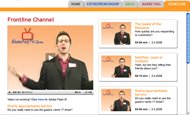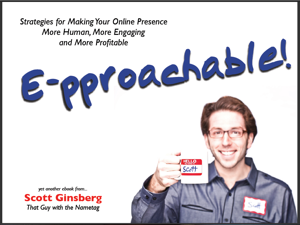 Years ago, Johnny Carson was interviewing a guest on The Tonight Show who was billed as one of the greatest salespeople who has ever lived.
Years ago, Johnny Carson was interviewing a guest on The Tonight Show who was billed as one of the greatest salespeople who has ever lived.
“Well, sell me something!” Johnny said.
“Okay, well, what do you want me to sell?” replied the man.
“How about this ashtray on my desk?”
And just as Johnny expected the man to go into a sales pitch, instead the salesman asked, “What do you like about this ashtray?”
Johnny spoke about its unusual shape, its color and how it matched other things on his desk.
Then, the guest asked how much Johnny would be willing to spend on it.
Johnny replied, “Oh, maybe ten dollars?”
“Sold!!” said the salesman.
LESSON LEARNED: When you deliver enough value, your customers close you.
(Special thanks to Sean McPheat for that story.)
That’s not selling – that’s enabling people to buy.
Here’s how to make it work for you:1. Create a significant emotional event. If you bring nothing but logic, you’ll never motivate customers to buy. Emotion is the only language that produces action. Which means: In your sales presentation, you have to create a multi-sensory experience.
Here’s how: According to the book Resonate, chronic bombardment means audiences are accustomed to quick action, rapid scene changes and soundtracks that make the heart race.
As you deliver your stories, solutions and suggestions – not your sales pitch, information and instructions – leverage color, light and motion. That’s what keeps humans engaged.
After all, there is a high customer expectation for visual and visceral stimulation. The human attention span is six seconds. And if you don’t pique their aesthetic perceptions and tickle their sensibilities, they’ll wait forever for you to close them.
Because the reality is: It’s not what you say, it’s not how you say it – it’s how people feel when they hear it. Information isn’t as essential as the emotional impact of the information. Do your customers love your process as much as your product?
2. Disarm the immediate preoccupation. Ideally, by embodying humor early. Notice I said, “embody,” not “use.” You can’t use humor like you use hair gel. But what you can do is discover your innate and inevitable funniness as a human being.
All you have to do is figure out what you’re clearly too much of: Too old? Too young? Too expensive? Too slow? Answer that question, then lead with it. You’ll find that by magnifying the unhideable, you convert pigeonholes into goldmines. By acknowledging what causes the tension; it will exhale in the form of customer laughter.
And as Jeffrey Gitomer explained in The Little Teal Book of Trust, “The funnier you are, the more engaging you are, the closer the customer will listen, and the more authentic you’re perceived to be. Getting people to laugh is tacit approval, and it’s your best change to deliver important facts. At the end of laughter is the height of listening.” Are you ignoring the elephant in the room, talking about the elephant or jumping on its back and teaching it how to dance?
3. Flip the pitch. Whenever a prospective client inquires about one of my seminars or corporate training programs, I always ask them, “Why is the idea of approachability important to your people?” Then they tell me. Then I listen. And then I allow them to sell me on the value of my own product. Bam!
Another example is my friend Matt. Whenever he’s uncertain about whether or not to pursue a prospective client, he boldly makes the following request: “Thanks for your interest in my program! Please write me a letter explaining why I should come and I’d be happy to consider it.”
The point is: Don’t be afraid to let your customers do the selling for you. Because if you say it, they’ll pay attention – but if they say it, they’ll pay money. Either way, just be sure your sales approach is underscored by the question, “How do you think I can help you?” Because it’s not your job to help them afford you – it’s your job to help them justify what they can afford. How could you turn your sales pitch on its head?
4. Consider your pre-sale position. If you walk in the door as a salesperson, you’re already at a deficit position. If you want customers to close you, make yourself a composite of the following power positions.
First, be a peer of the buyer. Which means you have to build commonality. And you do so by leading with your person and following with your profession.
Second, be a trusted resource to the buyer. Which means you have to build a value-forward platform online and offline. And you do so by thinking on paper, every single day.
Third, be a problem solver with the buyer. Which means you have to figure out what you’re the answer to. And you do so by using use social media to gain insight into what drives your customers up the wall, then becoming that answer to those issues.
Ultimately, the stronger your pre-sale position, the easier it is to get to yes. How would your closing ratio change if customers saw you as their trusted advisor – not their tricky salesperson?
5. Make them ask what’s next. All customers are control freaks. And they want to feel as if they’re autonomous and in control of their environment and actions. Your challenge – whether it’s over the phone, in person, via email or on a social networking site – is to preserve that sense.
For example, you know your customers are ready to close you when they ask reverse closing questions like, “What’s next?” or “What’s the next step?” If you get to that point, well done. Because the goal is spend so much time listening and delivering value that price doesn’t come up till the very end. Then, when it does – and they’re ready – they’ll ask you for the close.
After all: Customers want to be pilots – not passengers. Now, this requires you to surrender your time, your information and your own desire for control. But it’s worth it. Because customers who control their service experience with your company also control their spreading experience about your company. How do you preserve customer control?
6. Deliver an ongoing value message. Absence doesn’t make the heart grow fonder – absence makes people forget. That’s why anonymity is bankruptcy. The key is to deliver a continuous flow of education in a variety of media. After all, it’s not your job to tell customers how to consume you.
Whether you publish a newsletter, blog, social media news feed – or even deliver public seminars – the goal is to leave no barriers for people to become involved with you in inexpensive and accessible ways.
Personally, I use a combination of ezines, blogs, syndicated columns, video modules and social media. What’s your recipe? The cool part is, when you start to serve people as if they were already paying clients, you make it easier for them to close you at their own convenience.
Then, instead of taking a whiff of the stink of desperation, they savor the aroma of education. Are you treating customers as people who pay your salary, or attending to them as pupils who enrolled in your class?
7. Allow your customers to have their fingerprint on the solution. Then, when price comes up, as opposed to responding reflexively with a rigid, canned fee, try using language like this:
“With every engagement and every client, there are a number of variables that affect your final investment. Let’s look at what’s important to you and what’s important to me, and we can create a fee agreement that honors both of us.”
In short: Grow bigger ears. Because if salespeople would simply ask smart questions and shut the hell up, customers would sell themselves the entire time. My suggestion: Instead of being exhaustingly argumentative, be strategically inquisitive. Then, oxygenate the conversation by allowing the silence to hold you a little while longer. Give yourself a moment to let your customer’s words wash over you.
In so doing, long silence tells people that what they said is important. It communicates that their words have weight and deserve their own space before being banished by a reply. Do that, and they’ll close the sale before you even get around to it. Are you listening to the sound of your own voice or the music of your customer’s voice?
8. Help customers verbalize their hopes. It’s not about overcoming the objection – it’s uncovering why that objection is important to the customer. Because if you know people’s why – you don’t just have a hot button – you have their entire motherboard.
Not to control them, but to inspire them. Not to sell more stuff, but to make a difference. And not to deliberately fabricate fears that don’t exist, but to raise awareness of potential dangers by illustrating the cost of inaction.
In short: Beat the customer. Deliver their desire before they place it. Invest just as much time in anticipating than responding. That’s how you build a path of trust, humanize the sales experience and diffuse customers’ built in push-back mechanisms. Ultimately, if you want customers to close you, don’t sell the service – just deliver it in every breath. Are you trying to trick people into buying something, or trying to make something worth buying and spreading?
REMEMBER: Customers will always get what they want – it just might not be from you.
But if you can focus less on selling and more on enabling people to buy, the customer will close you quicker than you can say, “Sold!”
LET ME ASK YA THIS…
How closeable are you?
LET ME SUGGEST THIS…
For the list called, “26 Ways to Out Brand Your Competitors,” send an email to me, and you win the list for free!
* * * *
Scott Ginsberg
That Guy with the Nametag
Author, Speaker, Entrepreneur, Mentor
[email protected]
 Never the same speech twice.
Never the same speech twice.
Now booking for 2011-2012!
Watch The Nametag Guy in action here!

 Since I started my publishing company eight years ago, I’ve had the honor and privilege of working with some of the finest organizations around the world:
Since I started my publishing company eight years ago, I’ve had the honor and privilege of working with some of the finest organizations around the world: “Yeah, but it wasn’t worth it.”
“Yeah, but it wasn’t worth it.” The world’s FIRST two-in-one, flip-flop book!
The world’s FIRST two-in-one, flip-flop book! Not compliance – commitment.
Not compliance – commitment. 
 Every leader has an audience.
Every leader has an audience. The world’s FIRST two-in-one, flip-flop book!
The world’s FIRST two-in-one, flip-flop book! Welcome all Gitomer groupies!
Welcome all Gitomer groupies! Life is not a Nike commercial.
Life is not a Nike commercial. Last time I checked, being human was still good for business.
Last time I checked, being human was still good for business.  I recently read an article in The Onion that painted a frighteningly accurate picture of employee disengagement and dissatisfaction.
I recently read an article in The Onion that painted a frighteningly accurate picture of employee disengagement and dissatisfaction.